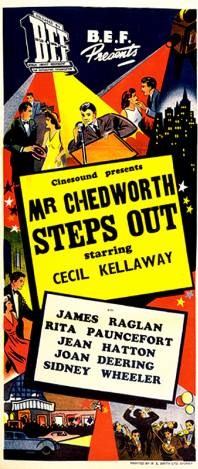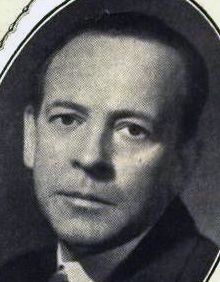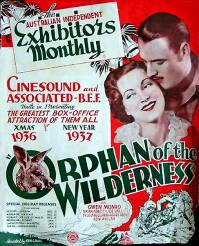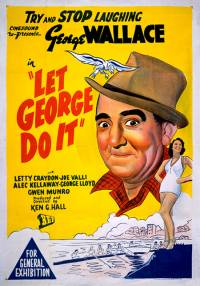Related Research Articles

Kenneth George Hall was an Australian film producer and director, considered one of the most important figures in the history of the Australian film industry. He was the first Australian to win an Academy Award.

Cinesound Productions Pty Ltd was an Australian feature film production company. Established in June 1931, Cinesound developed out of a group of companies centred on Greater Union Theatres that covered all facets of the film process, from production to distribution and exhibition. Cinesound Productions established a film studio as a subsidiary of Greater Union Theatres Pty Ltd based on the Hollywood model. The first production was On Our Selection (1932), which was an enormous financial success.

Shirley Ann Richards was an Australian actress and author who achieved notability in a series of 1930s Australian films for Ken G. Hall before moving to the United States, where she continued her career as a film actress, mainly as a Metro-Goldwyn-Mayer starlet. Her best known performances were in It Isn't Done (1937), Dad and Dave Come to Town (1938), An American Romance (1944), and Sorry, Wrong Number (1948). In the 1930s, she was the only Australian actor under a long-term contract to a film studio, Cinesound Productions. She subsequently became a lecturer and poet.

Mr. Chedworth Steps Out is a 1939 Australian comedy film directed by Ken G. Hall starring Cecil Kellaway. Kellaway returned to Australia from Hollywood to make the film, which features an early screen appearance by Peter Finch.

The Broken Melody is a 1938 Australian drama film directed by Ken G. Hall and starring Lloyd Hughes, based on a best-selling novel by F. J. Thwaites. Hall later said in 1974 that "This was a film that I’m particularly keen about still."

Frank Harvey was a British-born actor, producer, and writer, best known for his work in Australia.
The Squatter's Daughter is a 1933 Australian melodrama directed by Ken G. Hall and starring Jocelyn Howarth. One of the most popular Australian films of the 1930s, it is based on a 1907 play by Bert Bailey and Edmund Duggan which had been previously adapted to the screen in 1910.
The Silence of Dean Maitland is a 1934 Australian film directed by Ken G. Hall, and based on Maxwell Gray's 1886 novel of the same name. It was one of the most popular Australian films of the 1930s.

Thoroughbred is a 1936 Australian race-horse drama film directed by Ken G. Hall, partly based on the life and career of Phar Lap. Hollywood star Helen Twelvetrees was imported to Australia to appear in the film. The film also stars Frank Leighton and John Longden.

Orphan of the Wilderness is a 1936 Australian feature film from director Ken G. Hall about the adventures of a boxing kangaroo. It starred Brian Abbot who disappeared at sea not long after filming completed.
It Isn't Done is a 1937 Australian comedy film about a grazier who inherits a barony in England.

Lovers and Luggers is a 1937 Australian film directed by Ken G. Hall. It is an adventure melodrama about a pianist who goes to Thursday Island to retrieve a valuable pearl.

Let George Do It is a 1938 comedy starring popular stage comedian George Wallace. It was the first of two films Wallace made for Ken G. Hall at Cinesound Productions, the other one being Gone to the Dogs (1939). Hall later called Wallace "in my opinion, easily the best comedian that this country has produced."
Gone to the Dogs is a 1939 musical comedy vehicle starring George Wallace. It was the second of two films he made for director Ken G. Hall, the first being Let George Do It (1938).

Dad Rudd, M.P. is a 1940 comedy that was the last of four films made by Ken G. Hall starring Bert Bailey as Dad Rudd. It was the last feature film directed by Hall prior to the war and the last made by Cinesound Productions, Bert Bailey and Frank Harvey.
Splendid Fellows is a 1934 Australian film from director Beaumont Smith about an Englishman who comes to Australia. The cast includes Eric Colman, brother of Ronald Colman, and Sir Charles Kingsford Smith, who has a cameo as himself. It was Smith's last film.
Frank Leighton (1908–1962) was an Australian actor best known for two leading roles in films for Ken G. Hall, Thoroughbred (1936) and Tall Timbers (1937).
Tall Timber is a 1926 Australian silent film about a rich man who flees the city and works in a timber mill. It is considered a lost film.
Stuart Frank Doyle was an Australian radio and theatrical entrepreneur.
Big Timber is a 1936 Australian novel by William Hatfield.
References
- ↑ "AUSTRALIAN FILM". The Sydney Morning Herald . National Library of Australia. 4 December 1937. p. 12. Retrieved 14 August 2012.
- ↑ "Tall Timbers". Monthly Film Bulletin. 5 (49). London: 12. 1938. ProQuest 1305796738.
- 1 2 Andrew Pike and Ross Cooper, Australian Film 1900–1977: A Guide to Feature Film Production, Melbourne: Oxford University Press, 1998, 179.
- ↑ Pike, Andrew Franklin. "The History of an Australian Film Production Company: Cinesound, 1932-70" (PDF). Australian National University. p. 245.
- ↑ "AUSTRALIAN FILMS". The Sydney Morning Herald . National Library of Australia. 16 June 1932. p. 9. Retrieved 14 August 2012.
- ↑ "Notes on the Screen". The Argus . Melbourne: National Library of Australia. 6 November 1935. p. 10. Retrieved 10 August 2012.
- ↑ ""HERALD'S" NEW SERIAL". The Sydney Morning Herald . National Library of Australia. 22 February 1936. p. 11. Retrieved 10 August 2012.
- 1 2 3 4 Taylor, Philip (January 1974). "Ken G. Hall". Cinema Papers. p. 83.
- ↑ Vagg, Stephen (16 April 2020). "Audio Commentary for Tall Timbers" (Podcast). Anchor FM.
- ↑ "AUSTRALIAN FILM". The Sydney Morning Herald . National Library of Australia. 18 January 1937. p. 5. Retrieved 14 August 2012.
- ↑ "TREES TO CRASH ON MOUNTAIN". The Sydney Morning Herald . National Library of Australia. 20 January 1937. p. 13. Retrieved 14 August 2012.
- ↑ "TIMBER DRIVE HITCH". The Sydney Morning Herald . National Library of Australia. 23 January 1937. p. 17. Retrieved 14 August 2012.
- ↑ "Electrically-Controlled Blowfly to Worry Comedian!". The Sydney Morning Herald . National Library of Australia. 24 September 1940. p. 12 Supplement: Women's Supplement. Retrieved 14 August 2012.
- ↑ Clip from The 1930s Golden Era of Australian Movies: A Tribute to Ken G Hall AO OBE at Australian Screen Online
- ↑ "MUSIC AND DRAMA". The Sydney Morning Herald . National Library of Australia. 13 March 1937. p. 12. Retrieved 14 August 2012.
- ↑ "MR. S. F. DOYLE". The Sydney Morning Herald . National Library of Australia. 5 June 1937. p. 18. Retrieved 13 August 2012.
- ↑ "1200 DANCERS AT TALL TIMBERS BALL". The Sydney Morning Herald . National Library of Australia. 12 June 1937. p. 11. Retrieved 14 August 2012.
- ↑ "Congratulations, Cinesound!" Everyone's 28 July 1937 p 3
- ↑ "Timbers" Tops "Selection" Bris Record, Everyones, 18 August 1937 p 3
- ↑ "35,191 See "Tall Timbers" at Brisbane Tivoli", Everyones, 25 August 1937